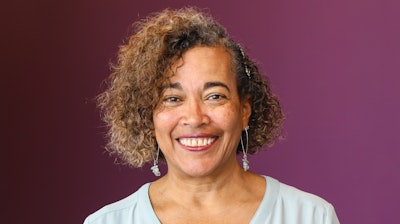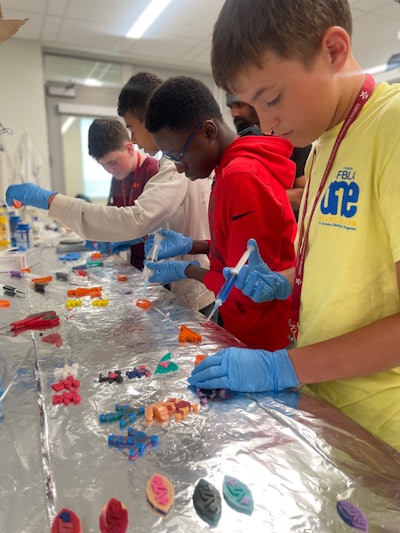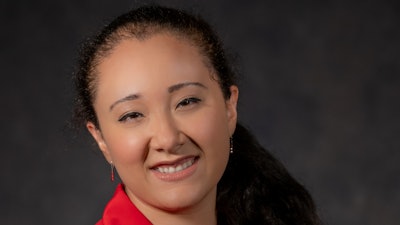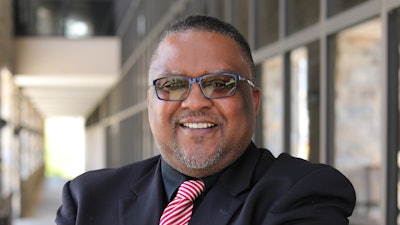Starting with programs for middle and high school students, through supports for graduate students, the Center for the Enhancement of Engineering Diversity (CEED) at Virginia Polytechnic Institute and State University (Virginia Tech) has provided inspiration, insight, encouragement, and community for engineering students.
 Dr. Bevlee WatfordTaylor Cupp
Dr. Bevlee WatfordTaylor Cupp
“Many of the programs that we put into existence are things that I wish that I had had,” says Watford, associate dean of equity and engagement and executive director of CEED.
Early in her time as an administrator at Virginia Tech, she implemented the Black Engineering Support Team (BEST), having Black upperclassmen be peer mentors to freshmen. Those freshmen remained bonded and, in time, became mentors. Such support has grown over the last three decades.
“Honestly, I’m still amazed every single day about what we have now,” Watford says. “It really started with 10 undergraduate students who wanted to be peer mentors to help the freshmen coming behind them.”
Inception
As an undergraduate, Watford was the only engineering student on her floor in the women’s dormitory. She found a peer network among the Black male engineering students, who were also in a stark minority at that time. There are now living-learning communities for engineering students — Hypatia for women and Galileo for men, offering each other encouragement and support in pursuing the engineering degree.
When she completed her Ph.D., she accepted a tenure-track position at Clemson University, quickly finding that female and minority students gravitated to her. Engaging with students was fulfilling, but Watford says she realized teaching was not her calling.
 The Center for the Enhancement of Engineering Diversity raises awareness for diversity in engineering and other technical fields.Taylor Cupp
The Center for the Enhancement of Engineering Diversity raises awareness for diversity in engineering and other technical fields.Taylor Cupp
Initially, she worked with Black students. As successful programming became established, the programs were replicated for women and other underrepresented minorities.
Students, she says, felt isolated in engineering because they were often the only Black students in some of their classes. Connecting Black students with each other made them feel stronger and more determined to support each other through the curriculum.
“It was a matter in many cases of asking the students, ‘What do you need?’” Watford says. “For a lot of them, it comes down to a sense of community.”
“Related to student success, CEED has a robust center that includes tutoring, mentoring, and advocacy for students to ensure they are on the path to achievement and graduation,” adds Dr. Karen Eley Sanders, associate vice provost for College Access. Sanders has worked with CEED in various capacities throughout her 22 years at Virginia Tech. “They also challenge and hold students accountable . . . by requiring students to be engaged with the apparatus they’ve built to help students be successful.”
 Young people in Virginia Tech's Center for the Enhancement of Engi- neering Diversity take part in pre-college STEM activities.Taylor Cupp
Young people in Virginia Tech's Center for the Enhancement of Engi- neering Diversity take part in pre-college STEM activities.Taylor Cupp
The target populations for undergraduate programming remain those who are underrepresented and underserved in engineering, but Watford makes it clear the programming is open to any Virginia Tech engineering student who wants to access it.
“I believe CEED is a national model,” Sanders says. “If colleges of engineering, colleges of science, and quite frankly non-STEM (science, technology, engineering, and mathematics) academic units would build the infrastructure that CEED has, they, too, would see an increase in the achievement, success, graduation, and graduate enrollment for first-generation and underrepresented students.”
Encouragement
Watford inherited one pre-college program that already existed for seventh and eighth graders, providing information about electrical and computer engineering. It is now called Imagination.
After undergraduate programming demonstrated improved retention and graduation rates, Watford was able to recruit students to Virginia Tech. That began with pre-college summer camps to introduce students to engineering and the university.
Today, there are robust pre-college programs serving 1,000 to 1,500 students. These are mostly summer programs except for Pathways for Future Engineers, a multi-year program for first-generation students from the state of Virginia who are provided with experiential learning opportunities.
Watford credits Kim Lester, director of pre-college programs, with creating many of the different concepts and content as well as securing funding. Lester has a network of teachers and guidance counselors that have their students apply for summer programs. Faculty from the College of Engineering and College of Sciences play an essential role.
“They donate their time to create age-appropriate, hands-on activities for these students that come to our camps,” says Watford. “Faculty do it as part of their research and part of their service to the university and to the state.”
Building Leaders for Advancing Science and Technology (BLAST) serves rising ninth and 10th graders, designed to help students find their place in STEM. One of the most popular programs is C-Tech², designed for rising high school junior and senior girls, giving them access to information and technology necessary to prepare for their futures.
“CEED has always been both gender and ethnic, racial diversity focused,” says Watford. “I’ve had other institutions ask me to come and visit, or they came to visit here to see what kinds of programs we have and how we implement them.”
Dr. Katrina Colucci-Chang, now a biomedical engineer/project manager with the U.S. Navy, found her STEM identity at a Virginia Tech summer program. She has a multi-racial background and grew up in Puerto Rico, where her father was a chemical engineering professor. Despite her father taking her to his lab so she could see female students working there, she didn’t feel a full sense of possibility until participating in C-Tech².
 Dr. Katrina Colucci-ChangTaylor Cupp
Dr. Katrina Colucci-ChangTaylor Cupp
“Seeing women my age interested in engineering and science gave me that boost to continue science,” she continues. “Now, I try to give back . . . by mentoring girls and young women to keep going in engineering. It goes back to CEED workshops where they gave us mentorship skills.”
Colucci-Chang’s story illustrates the “beauty of the pipeline,” says Sanders, whose current role involves ensuring Virginia Tech has a concerted, broad effort to reach out to underrepresented communities to make sure students are prepared for higher education.
“CEED fosters access by broadly reaching out to underrepresented and underserved communities,” says Sanders, who explains that CEED informs students starting in middle school about the skills they need to acquire before coming to college to study engineering. “They engage the students and help them become aware of the opportunities in STEM. They do that by bringing kids to campus to learn about the college path, to participate in hands-on critical thinking activities that get them excited about the path to college and science.”
Expanded focus
Further advancement came when Dr. Tremayne O. Waller joined Virginia Tech in 2018 as director of Graduate Student Programs. Waller does not come from an engineering background, but when he began studying for his master’s degree in counseling and human development, he found himself fascinated with engineering, which led him to Virginia Tech for his doctoral studies in curriculum instruction. His dissertation research was on the CEED summer programs. After completing his Ph.D. in 2009, he worked at other institutions before returning to work with Watford, whom he calls a superwoman that forges collaborations and helps others climb the ladder of success.
Waller says many students, despite being undergraduates studying engineering, might not fully understand the possibility of going to graduate school. To address that, there are now approximately 40 graduate ambassadors who will speak to student groups about their journeys.
Sanders says CEED makes sure that Virginia Tech undergraduates are exposed to graduate education.
 Dr. Tremayne O. WallerTaylor Cupp
Dr. Tremayne O. WallerTaylor Cupp
There is an umbrella organization for the minority organizations at Virginia Tech, CAMEO (Council for the Advancement of Minority Engineering Organizations), which provides funding and scholarships and organizes the CAMEO CareerFest each spring.
Waller also attends national conferences, such as the National Society of Black Engineers, to recruit graduate students. Being present at these conferences helps raise the profile of Virginia Tech’s graduate programs as well as awareness of CEED’s support services.
“I can go to conferences to build relationships with these students, creating a database, bringing it back, and sharing it with the department to do outreach,” Waller says. “The CEED graduate ambassadors contact the students to make connections. You have to be in contact with underrepresented students to get them to come.”
Colucci-Chang attended George Mason University for her undergraduate engineering studies, but she says she knew she would return to Virginia Tech for graduate school. CEED gave her a support network throughout the arduous doctoral studies, and that network continues to this day as its members pursue their careers. New Horizons Graduate Scholars was instrumental in keeping her grounded when the COVID-19 pandemic hit as she was doing research for her dissertation.
“During COVID, Dr. Waller would have Tuesday lunches via Zoom and on Fridays, Zoom virtual games,” Colucci-Chang recalls. “Even though I was in my apartment, I still felt a sense of community.”
Waller says CEED continues to build on the New Horizons program. Data from the participants helps shape advising and accountability measures.
Grant proposals are written to support additional CEED projects. A current major effort is to build relationships with HBCUs (Historically Black Colleges and Universities) and MSIs (Minority-Serving Institutions) to create mutual pathways. This involves helping fund HBCU institutions’ research labs, “not only to diversify on our end, but to also give back to those HBCUs and MSIs,” says Waller. As no HBCU has Carnegie Classification Research 1 status yet, Virginia Tech provides a welcoming environment for HBCU graduates desirous of doing graduate studies at a Research 1 institution.
Sanders says Virginia Tech has learned a lot from HBCUs and infused the inclusive advising and support mechanisms that help students of all backgrounds be academically successful. Growing the diversity of the faculty is among the institution’s priorities, and CEED’s graduate student programming contributes candidates.
Waller says he is about creating programs that work. “We want them to come to Virginia Tech, but if they don’t, that’s OK,” he says. “We want to show, ‘you can do this,’ and ‘this is how students can be successful.’”





















